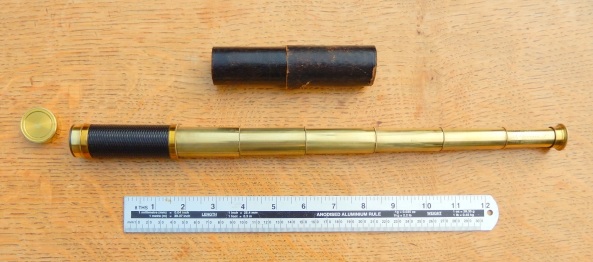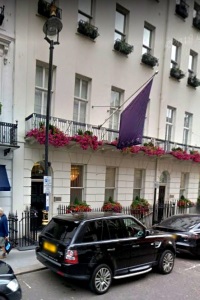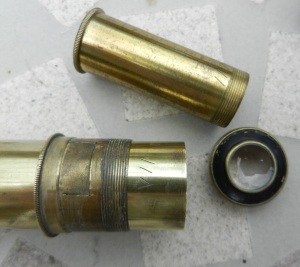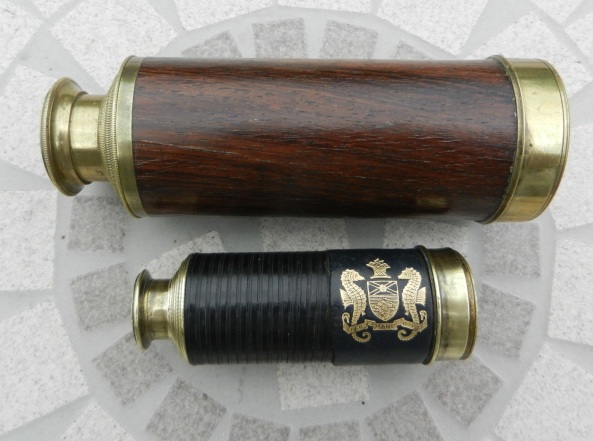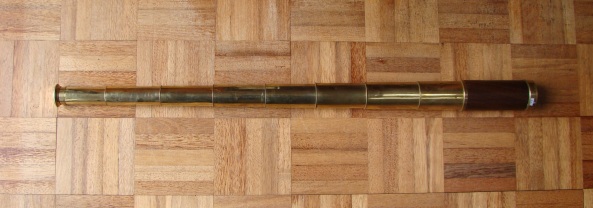
Carpenter telescope fully extended
This is a favourite of mine. It’s small, or compact might be the word, when closed up – it almost fits in your pocket. It certainly fits in a coat pocket. Yet when extended to operating length, it’s long enough to be impressive, but above all it works well. So it is the ideal telescope to use on holiday.
Description
There is a rosewood veneer over the (presumably brass) barrel. This contains eight brass draws, all just above 3” (8.2cms) long.

Engraving on the eyepiece.
The outer diameter is about 2”, and the closed up length 5.5”. There is no sunshade, and no lens cover over the objective, that is probably missing. The eyepiece has a flat end, with a sliding cover over the aperture. On the flat end of the eyepiece the engraving says “CARPENTER – LONDON”: while the word London is fairly even, on a straight line, the “Carpenter” is on an arc, not quite centred on the centre of the eyepiece, with varying weight/punch angle and quite unevenly spaced – as if done by hand, unevenly. Over to the left there are a number of dots in what seems to be a vertical line – with eight dots it looks deliberate, rather than an accidental mark. Incongruously, this line of dots is absolutely in a straight line. Maybe this indicates the eight draws of this model?
In use, the extended length overall is 27”. The second set of eyepiece lenses are at the end of the second draw, so focus is adjusted from the second to third draw, keeping the first draw fully extended.
Supplier

Dismantled into the eight sections, with eight close fitting sliders left in place on the draws
This telescope was found at the Scientific and Medical Instruments Fair, at the Portman Hotel in London, 29th October 1995.
Surprisingly, it was filthy, with the wood looking very tatty, and dirty lenses. The supplier was Alan Jones (Nautical and Scientific Instruments) of Plympton and Plymouth, PL7 5AS. It was still expensive – a marked price of £185 was knocked down to £170. Admittedly it is quite an effort to dismantle all the pulls to clean them. The most satisfying results of cleaning were seen with the rosewood veneer, after stripping off the original polish it was cleaned with linseed oil and turps, then polished with beeswax and more linseed oil.
Carpenter of London
 The Carpenter family story seems to start at around 1808, with William and Philip Carpenter working in Inge Street, Birmingham. In 1826 Philip Carpenter opened in London, and in 1827-33 he was at 24 Regent Street, at the corner of Jermyn Street. Interestingly, Gloria Clifton quotes him as making kaleidoscopes, microscopes and microscope accessories. He died in 1833, and from 1834-37 his sister Mary (quoted as an Optician) ran the business at this address. From 1837 onwards Mary went into partnership with William Westley, and Carpenter and Westley continued through to 1914. Certainly from 1828 up till 1835 there was a factory in Birmingham supplying the Carpenter London shop, but apparently Carpenter and Westley re-sold stock from Negretti & Zambra. There were also some other instrument and toy makers in Birmingham named Carpenter at this time.
The Carpenter family story seems to start at around 1808, with William and Philip Carpenter working in Inge Street, Birmingham. In 1826 Philip Carpenter opened in London, and in 1827-33 he was at 24 Regent Street, at the corner of Jermyn Street. Interestingly, Gloria Clifton quotes him as making kaleidoscopes, microscopes and microscope accessories. He died in 1833, and from 1834-37 his sister Mary (quoted as an Optician) ran the business at this address. From 1837 onwards Mary went into partnership with William Westley, and Carpenter and Westley continued through to 1914. Certainly from 1828 up till 1835 there was a factory in Birmingham supplying the Carpenter London shop, but apparently Carpenter and Westley re-sold stock from Negretti & Zambra. There were also some other instrument and toy makers in Birmingham named Carpenter at this time.
So it is likely this telescope with the Carpenter name, and from a London shop, was produced between 1826 and 1837.
Probable use
Because this is a very compact telescope, it would have been attractive for use by Cavalry officers or land troops in charge of artillery etc. But presumably the Regent Street shop (I assume) was chosen to attract attention from the wealthy shoppers passing by, which might have been land owners visiting London. So the target market might have been more for the gentry to use on their travels, or their country estates.
Where does it fit
 The two draw Ramsden and Berge telescopes made in the 1790s probably pushed the designs of the time as far as they could go, in relation to the availability of different sized accurate tubing, which had to be both smooth on the outside and circular in section: so piping constructed with a welded or brazed seam was not suitable. But then we have the Watkins telescope from 1890, which was the previous one listed on here, with a long four draw design. In the early 1790s and 1800s such tubing in different sizes was becoming available, and probably operating from Birmingham factories the Carpenters were aware of the latest materials and machining techniques. Presumably in this era a major industry had developed, producing the rifles, cannons, and ammunition, maybe also later on pistols, with shell cases etc in brass, all of which stretched the gun drilling and tube boring technology. So I see this Carpenter type, from 1830, as taking advantage of the materials then available, and skilled enough in machining to not be daunted by the task of producing all the threads and fitments! There are other manufacturers who possibly produced such multi-draw telescopes, even Dollond, but unless we guess from the type of script used on the side of the Dollond scopes we have no easy way of dating them!
The two draw Ramsden and Berge telescopes made in the 1790s probably pushed the designs of the time as far as they could go, in relation to the availability of different sized accurate tubing, which had to be both smooth on the outside and circular in section: so piping constructed with a welded or brazed seam was not suitable. But then we have the Watkins telescope from 1890, which was the previous one listed on here, with a long four draw design. In the early 1790s and 1800s such tubing in different sizes was becoming available, and probably operating from Birmingham factories the Carpenters were aware of the latest materials and machining techniques. Presumably in this era a major industry had developed, producing the rifles, cannons, and ammunition, maybe also later on pistols, with shell cases etc in brass, all of which stretched the gun drilling and tube boring technology. So I see this Carpenter type, from 1830, as taking advantage of the materials then available, and skilled enough in machining to not be daunted by the task of producing all the threads and fitments! There are other manufacturers who possibly produced such multi-draw telescopes, even Dollond, but unless we guess from the type of script used on the side of the Dollond scopes we have no easy way of dating them!
While probably not the first multiple draw telescope, it does enable the owner to boast about the obvious skills of the machinists!
Holiday use

The Carpenter scope in use at ‘The Ship’ Inn, Midships at Porthleven in 2006
Beware! If you carry the telescope in your hand luggage, as is the sensible thing to do, the Security people with X-ray machines are a little confused as to what the object is, when they see several concentric tubes linked together in what looks like a hand grenade sized object! Strangely the security guards I met had never seen anyone carrying a telescope before, I thought it was quite a normal thing to do.
This telescope also regularly comes away on holiday within England, it easily fits under the car seat. Most of its trips take it back to Cornwall.
What is it worth today?
Probably £250-300 only: it is accession number 29. I just like the design so bought another similar one, which I must find, but I don’t think the second one is named. No, it isn’t named, it is number 156. It is the same length as the Carpenter when closed, but much larger diameter, so not so pocket friendly, and heavier. The Carpenter weighs 600 gms, this other one weighs 820gms. It has 9 draws, or maybe 8.5, because the first one seems to be an afterthought to get the lenses in the right place! Its also fully lacquered, which I don’t like, and lacking a leather cover on the barrel. So buying another was obviously a mistake!
0.000000
0.000000

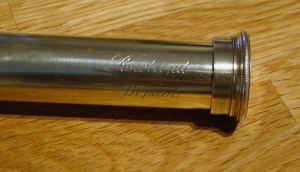 The only visible engraving is on the first draw, which says simply “Rowland Bristol”, so does not give any specific date information, in relation to the several generations of Rowland instrument makers in Bristol.
The only visible engraving is on the first draw, which says simply “Rowland Bristol”, so does not give any specific date information, in relation to the several generations of Rowland instrument makers in Bristol.
 This multi-draw has another, unique approach. The draws are relatively long, such that the second cartridge needs to be positioned half way along the second draw, for optimum performance. So the second cartridge is small enough to fit inside the first draw, except for the rear (ie objective end) lens mount ring. This ring is large enough to be caught by an internal shoulder in the second draw, half way along, which pulls the lens cartridge along into the middle of the second draw, when the scope is opened up. Ingenious!
This multi-draw has another, unique approach. The draws are relatively long, such that the second cartridge needs to be positioned half way along the second draw, for optimum performance. So the second cartridge is small enough to fit inside the first draw, except for the rear (ie objective end) lens mount ring. This ring is large enough to be caught by an internal shoulder in the second draw, half way along, which pulls the lens cartridge along into the middle of the second draw, when the scope is opened up. Ingenious!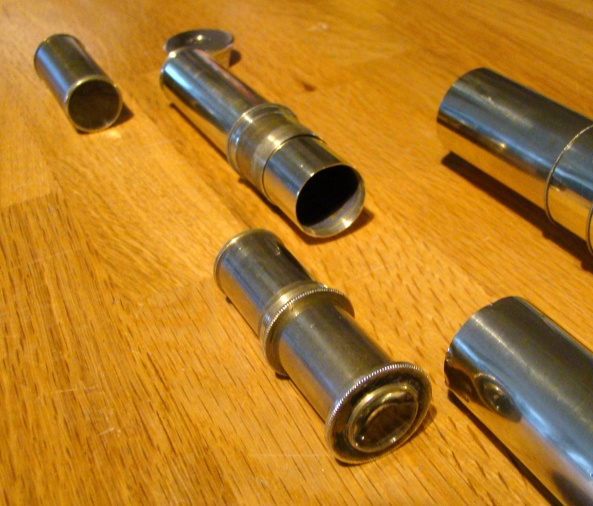
 There are a couple of issues with the cosmetic condition: there is some damage to the eyepiece end of the second draw, which has a couple of dents. These can be seen in the photo opposite. Then the barrel paintwork is severely chipped, ie most of it is missing. It would benefit from a leather sleeve: hopefully a picture will follow with such a leather cover.
There are a couple of issues with the cosmetic condition: there is some damage to the eyepiece end of the second draw, which has a couple of dents. These can be seen in the photo opposite. Then the barrel paintwork is severely chipped, ie most of it is missing. It would benefit from a leather sleeve: hopefully a picture will follow with such a leather cover.


 The second question would be as to whether there might be a demand – nowadays we would say a market – for such a design, when many of the scopes were used on-board ships. There, on board, there was plenty of space, and the small (pocket?) size (when collapsed) would not be needed. Ramsden, and Berge who followed him, also served the market for the country gentleman, who wanted a smaller, easy to carry telescope: see the “Gentleman’s silver telescope” on this website, and the Ramsden 3-draw units. There was also a market with cavalry officers, who needed units they could easily either carry in a small leather tube, or pack onto a horse. Watkins produced such scopes, as we see in the story about Captain Gerrard on this site, who used it later in the C19th, or also see the Bianchi 3-draw scope used by Lt Rolfe in the Peninsular War (1807). So it seems the demand would have been there.
The second question would be as to whether there might be a demand – nowadays we would say a market – for such a design, when many of the scopes were used on-board ships. There, on board, there was plenty of space, and the small (pocket?) size (when collapsed) would not be needed. Ramsden, and Berge who followed him, also served the market for the country gentleman, who wanted a smaller, easy to carry telescope: see the “Gentleman’s silver telescope” on this website, and the Ramsden 3-draw units. There was also a market with cavalry officers, who needed units they could easily either carry in a small leather tube, or pack onto a horse. Watkins produced such scopes, as we see in the story about Captain Gerrard on this site, who used it later in the C19th, or also see the Bianchi 3-draw scope used by Lt Rolfe in the Peninsular War (1807). So it seems the demand would have been there. The details of the design are just what would be expected from Ramsden, and are very high quality: I would say beautiful but that would make it subjective. The connectors between the draws are built with the threads recessed into the receiving draw by around an inch, and with a shoulder under the end of the receiving draw tube, to increase/improve the rigidity of the optical axis of the scope. The thread length used is also longer than average. This approach is also used on the examples of multi-draw telescopes produced (later) by Cary, Abraham, Cox and Carpenter, that I have in my own collection. It was not used on any of the 3 or 4-draw telescopes produced by Ramsden or Berge that I have seen.
The details of the design are just what would be expected from Ramsden, and are very high quality: I would say beautiful but that would make it subjective. The connectors between the draws are built with the threads recessed into the receiving draw by around an inch, and with a shoulder under the end of the receiving draw tube, to increase/improve the rigidity of the optical axis of the scope. The thread length used is also longer than average. This approach is also used on the examples of multi-draw telescopes produced (later) by Cary, Abraham, Cox and Carpenter, that I have in my own collection. It was not used on any of the 3 or 4-draw telescopes produced by Ramsden or Berge that I have seen. The internal lens cartridges and lens mounts are well constructed, and all the threads on this example are easily unscrewed: even the objective lens pair and its mounting. It has an objective lens cap, for protection, but no sunshade: this is similar to the other designs of smaller scopes, and the multi-draws quoted above.
The internal lens cartridges and lens mounts are well constructed, and all the threads on this example are easily unscrewed: even the objective lens pair and its mounting. It has an objective lens cap, for protection, but no sunshade: this is similar to the other designs of smaller scopes, and the multi-draws quoted above.

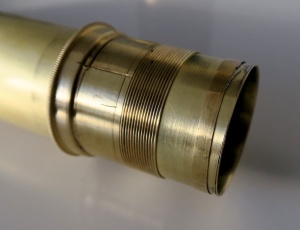 My colleague who has this telescope considers the 4th draw to be different in construction, but I regret I can’t understand what function the difference might have, or whether it is real. There is a separate photo of this draw, it is possibly a shorter length, reduced by 12-15mm at least, with a separate (mounting?) ring on the end of the connector. It might be that this element (draw) had a problem in production, and the extra ring was needed to ensure the correct mounting position/alignment of the tubes? Or did it just reduce the full extended length to make the focus easier to locate?
My colleague who has this telescope considers the 4th draw to be different in construction, but I regret I can’t understand what function the difference might have, or whether it is real. There is a separate photo of this draw, it is possibly a shorter length, reduced by 12-15mm at least, with a separate (mounting?) ring on the end of the connector. It might be that this element (draw) had a problem in production, and the extra ring was needed to ensure the correct mounting position/alignment of the tubes? Or did it just reduce the full extended length to make the focus easier to locate?

 Also inside the case was a soft cushioned end piece, which fitted the eyepiece end of the telescope – so obviously this part of the case was meant to accept the eyepiece, rather than the objective. On the back of the cushioning the words forming the remains of some writing were in French, so along with the appearance of the scope this convinced me that the telescope was actually a French design, probably sold in England. Because it is such a small pocket telescope version, you assume it was sold to a country gent, to be carried in his pocket.
Also inside the case was a soft cushioned end piece, which fitted the eyepiece end of the telescope – so obviously this part of the case was meant to accept the eyepiece, rather than the objective. On the back of the cushioning the words forming the remains of some writing were in French, so along with the appearance of the scope this convinced me that the telescope was actually a French design, probably sold in England. Because it is such a small pocket telescope version, you assume it was sold to a country gent, to be carried in his pocket. The cartridge in the first draw was fine, but the second cartridge appeared to be at the end of the first draw. It became obvious that the telescope in fact had a sixth draw, and this draw was very stiff, possibly because it had been distorted. Withdrawing the second cartridge showed that the second, inner lens was missing. This lens was located – it was jammed up the first draw tube, held in place because its own over-sized knurled mounting ring was too big to slide easily inside the first draw, when the scope was fully collapsed. This had possibly led to the distortion of the first draw, and it does appear to be a design fault.
The cartridge in the first draw was fine, but the second cartridge appeared to be at the end of the first draw. It became obvious that the telescope in fact had a sixth draw, and this draw was very stiff, possibly because it had been distorted. Withdrawing the second cartridge showed that the second, inner lens was missing. This lens was located – it was jammed up the first draw tube, held in place because its own over-sized knurled mounting ring was too big to slide easily inside the first draw, when the scope was fully collapsed. This had possibly led to the distortion of the first draw, and it does appear to be a design fault. Even more interesting was that there was a supplier name engraved on the first draw, which was “S & B Solomons, 39 Albemarle St, London”. The Solomons were opticians and spectacle makers, and accepted London suppliers of telescopes and microscopes: it is possible that this was an imported French-made pocket telescope, brought in to provide their ‘Landed Gentry’ customers with impressive pocket-sized devices. Albemarle Street is off the Strand in Central London, and Samuel and Benjamin Solomons were operating there from 1840 to 1875, throughout the early Victorian period.
Even more interesting was that there was a supplier name engraved on the first draw, which was “S & B Solomons, 39 Albemarle St, London”. The Solomons were opticians and spectacle makers, and accepted London suppliers of telescopes and microscopes: it is possible that this was an imported French-made pocket telescope, brought in to provide their ‘Landed Gentry’ customers with impressive pocket-sized devices. Albemarle Street is off the Strand in Central London, and Samuel and Benjamin Solomons were operating there from 1840 to 1875, throughout the early Victorian period.